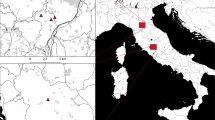Abstract
Background
Pigs are the main host species for the pseudorabies virus. It causes fatal encephalitis in many species, including humans. This article aims to report the first clinical case of pseudorabies as well as isolation and molecular characterization of the virus from a hunting dog in Bursa province, Turkey.
Methods and results
The dog shows clinical signs including pruritus and neurological signs such as stumbling and inability to stand up compatible with pseudorabies. The virus isolates were obtained from the supernatant of fresh tissue samples from the cerebellum, cornu ammonis, spleen, salivary gland, conjunctival swab, serum, and PBMC samples. The glycoprotein C region is targeted for viral DNA amplification. Pseudorabies virus genome detected both in fresh tissues and supernatants of third passage on Vero cells. The number of PCR positive samples was dramatically increased after cell culture inoculations. Genome sequencing of strain Bursa-10303, which was isolated from a non-endemic area, identified it to belong to clade A.
Conclusions
This study confirms the possible presence of pseudorabies infection in the wildlife reservoirs in Turkey. Future studies may clarify the importance of the infection in Turkey region, where there is no prevalent pig production.





Similar content being viewed by others
References
Pomeranz LE, Reynolds AE, Hengartner CJ (2005) Molecular biology of pseudorabies virus: impact on neurovirology and veterinary medicine. Microbiol Mol Biol Rev 69:462–500. https://doi.org/10.1128/mmbr.69.3.462-500.2005
He W, Auclert LZ, Zhai X et al (2019) Interspecies transmission, genetic diversity, and evolutionary dynamics of pseudorabies virus. J Infect Dis 219:1705–1715. https://doi.org/10.1093/infdis/jiy731
Mettenleiter TC (2000) Aujeszky’s disease (pseudorabies) virus: the virus and molecular pathogenesis—State of the art, June 1999. Vet Res 31:99–115. https://doi.org/10.1051/vetres:2000110
Wang D, Tao X, Fei M et al (2020) Human encephalitis caused by pseudorabies virus infection: a case report. J Neurovirol 26:442–448. https://doi.org/10.1007/s13365-019-00822-2
Wong G, Lu J, Zhang W, Gao GF (2019) Pseudorabies virus: a neglected zoonotic pathogen in humans? Emerg Microbes Infect 8:150–154
Kaneko C, Kaneko Y, Sudaryatma PE et al (2021) Pseudorabies virus infection in hunting dogs in Oita, Japan: report from a prefecture free from Aujeszky’s disease in domestic pigs. J Vet Med Sci. https://doi.org/10.1292/jvms.20-0450
Pedersen K, Turnage CT, Gaston WD et al (2018) Pseudorabies detected in hunting dogs in Alabama and Arkansas after close contact with feral swine (Sus scrofa). BMC Vet Res 14:388. https://doi.org/10.1186/s12917-018-1718-3
Tu L, Lian J, Pang Y et al (2021) Retrospective detection and phylogenetic analysis of pseudorabies virus in dogs in China. Arch Virol 166:91–100. https://doi.org/10.1007/s00705-020-04848-4
Serena MS, Metz GE, Lozada MI et al (2018) First isolation and molecular characterization of suid herpesvirus type 1 from a domestic dog in Argentina. Open Vet J 8:131–139. https://doi.org/10.4314/ovj.v8i2.3
Cano-Terriza D, Martínez R, Moreno A et al (2019) Survey of Aujeszky’s disease virus in hunting dogs from Spain. EcoHealth 16:351–355. https://doi.org/10.1007/s10393-019-01426-2
Fray MD, Paton D, Alenius S (2000) The effects of bovine viral diarrhoea virus on cattle reproduction in relation to disease control. Anim Reprod Sci 60:615–627. https://doi.org/10.1016/S0378-4320(00)00082-8
Steinrigl A, Revilla-Fernández S, Kolodziejek J et al (2012) Detection and molecular characterization of Suid herpesvirus type 1 in Austrian wild boar and hunting dogs. Vet Microbiol 157:276–284. https://doi.org/10.1016/j.vetmic.2011.12.033
Cramer SD, Campbell GA, Njaa BL et al (2011) Pseudorabies virus infection in Oklahoma hunting dogs. J Vet Diagnostic Investig 23:915–923. https://doi.org/10.1177/1040638711416628
Fonseca AA, Camargos MF, de Oliveira AM et al (2010) Molecular epidemiology of Brazilian pseudorabies viral isolates. Vet Microbiol 141:238–245. https://doi.org/10.1016/j.vetmic.2009.09.018
Moreno A, Sozzi E, Grilli G et al (2015) Detection and molecular analysis of Pseudorabies virus strains isolated from dogs and a wild boar in Italy. Vet Microbiol 177:359–365. https://doi.org/10.1016/j.vetmic.2015.04.001
Yildirim S, Özkan C, Yener Z et al (2017) Van’da bir ınekte yalancı kuduz (aujeszky) hastalığının ımmunohistokimyasal teşhisi. Kafkas Univ Vet Fak Derg 23:173–176. https://doi.org/10.9775/kvfd.2016.16071
Lin W, Shao Y, Tan C et al (2019) Commercial vaccine against pseudorabies virus: A hidden health risk for dogs. Vet Microbiol 233:102–112. https://doi.org/10.1016/j.vetmic.2019.04.031
Ciarello FP, Capucchio MT, Ippolito D et al (2020) First report of a severe outbreak of Aujeszky’s disease in Cattle in Sicily (Italy). Pathogens 9:1–15. https://doi.org/10.3390/pathogens9110954
Zhang L, Zhong C, Wang J et al (2015) Pathogenesis of natural and experimental Pseudorabies virus infections in dogs Herpes viruses. Virol J. https://doi.org/10.1186/s12985-015-0274-8
Karger A, Schmidt J, Mettenleiter TC (1998) Infectivity of a pseudorabies virus mutant lacking attachment glycoproteins C and D. J Virol 72:7341–7348
Wu YQ, Chen DJ, Bin HH et al (2012) Pseudorabies virus infected porcine epithelial cell line generates a diverse set of host microRNAs and a special cluster of viral microRNAs. PLoS ONE. https://doi.org/10.1371/journal.pone.0030988
Wang X, Wu CX, Song XR et al (2017) Comparison of pseudorabies virus China reference strain with emerging variants reveals independent virus evolution within specific geographic regions. Virology 506:92–98. https://doi.org/10.1016/j.virol.2017.03.013
Acknowledgements
The authors thank veterinarian Dr. Evren Bulgaç for presenting the case and providing the samples.
Funding
Not applicable.
Author information
Authors and Affiliations
Corresponding author
Ethics declarations
Conflict of interest
The authors declare that they have no conflicts of interest.
Ethical approval
This study was approved by the Bursa Uludag University Experimental Animals Local Ethics Committee in accordance with ethical guidelines for the Care and Use of Laboratory Animals (approval number: HADYEK; 2021–05/01).
Additional information
Publisher's Note
Springer Nature remains neutral with regard to jurisdictional claims in published maps and institutional affiliations.
Supplementary Information
Below is the link to the electronic supplementary material.
Rights and permissions
About this article
Cite this article
Aytogu, G., Toker, E.B., Yavas, O. et al. First isolation and molecular characterization of pseudorabies virus detected in Turkey. Mol Biol Rep 49, 1679–1686 (2022). https://doi.org/10.1007/s11033-021-06974-x
Received:
Accepted:
Published:
Issue Date:
DOI: https://doi.org/10.1007/s11033-021-06974-x




